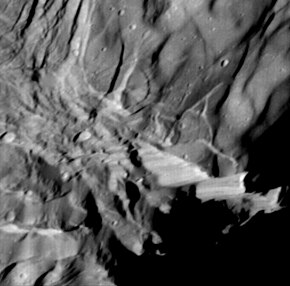18°18′S 347°48′E / 18.3°S 347.8°E / -18.3; 347.8
 Verona Rupes, right of center, photographed by Voyager 2 in January 1986. Verona Rupes, right of center, photographed by Voyager 2 in January 1986. | |
| Feature type | Scarp |
|---|---|
| Location | Miranda |
| Coordinates | 18°18′S 347°48′E / 18.30°S 347.80°E / -18.30; 347.80 |
| Diameter | 116.0 km (72.1 mi) |
| Peak |
|
| Discoverer | Voyager 2 |
| Eponym | Verona, the setting for Romeo and Juliet |
Verona Rupes is the tallest known cliff on Miranda, a moon of Uranus, and plausibly holds the record for the highest cliff in the Solar System. It was discovered by the Voyager 2 space probe in January 1986. Its name was adopted by the International Astronomical Union (IAU) in 1988, named after the city of Verona, which is the setting for Romeo and Juliet, written by William Shakespeare. It may have been created by a major impact that caused the moon to disrupt and reassemble, or by the crust rifting. Given Miranda's low gravity, it would take about 12 minutes to fall from the top, reaching the bottom at a speed of about 200 km/h.
There are many estimates about the cliff's height. It was thought its height was between 5 to 10 km (3 to 6 mi) high, while another places it at a higher altitude of 20 km (12 mi), potentially making it the tallest known cliff in the Solar System. One study estimated that the "true" height of Verona Rupes is around 5 to 15 km (3 to 9 mi) when not accounting for oblique viewing caused by parallax, gradually getting more shallow towards the terminator. It may be presumed that the scarp extends beyond the terminator, into the northern hemisphere, in which the Voyager 2 probe cannot view farther than. The scarp's slope with regard to the dark limb that extends past the terminator is estimated to be around 25 to 30 degrees.
References
- "PIA00044: Miranda high resolution of large fault". JPL, NASA. Retrieved 2007-07-23.
- ^ "Verona Rupes". Gazetteer of Planetary Nomenclature. USGS Astrogeology Research Program.
- ^ "1991LPI....22.1341S Page 1341". adsabs.harvard.edu. Retrieved 2024-08-04.
- ^ Thomas, P.C. (1988). "Radii, shapes, and topography of the satellites of Uranus from limb coordinates". Icarus. 73 (3): 427–441. Bibcode:1988Icar...73..427T. doi:10.1016/0019-1035(88)90054-1.
- ^ "APOD: 2016 November 27 - Verona Rupes: Tallest Known Cliff in the Solar System". apod.nasa.gov. Retrieved 2018-02-20.
- "Miranda". USGS. 2003-05-08. Archived from the original on July 4, 2003. Retrieved 2006-11-28.
- Chaikin, Andrew (2001-10-16). "Birth of Uranus' provocative moon still puzzles scientists". space.com. Imaginova Corp. p. 1. Archived from the original on July 9, 2008. Retrieved 2007-07-23.
- Chaikin, Andrew (2001-10-16). "Birth of Uranus' provocative moon still puzzles scientists". space.com. Imaginova Corp. p. 2. Retrieved 2007-07-23.
- Plescia, J. B. (1988-03-01). "Cratering history of Miranda: Implications for geologic processes". Icarus. 73 (3): 442–461. doi:10.1016/0019-1035(88)90055-3. ISSN 0019-1035.
| Moons of Uranus | |||||
|---|---|---|---|---|---|
| |||||
| Inner | |||||
| Major (spheroid) | |||||
| Outer (irregular) |
| ||||
| Geological features | |||||